Gallantry Awards
Gallantry medals are issued to individuals for personal acts of bravery during conflict. Many of the medals and awards issued are still in use today and are given to those who have gone above and beyond the call of duty.
Military Cross
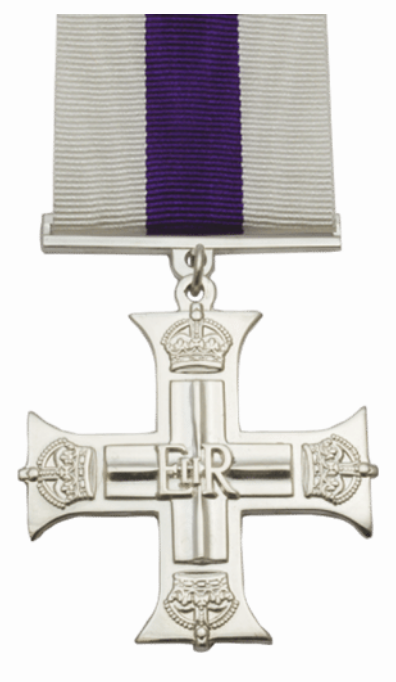
History
World War 1
The Military Cross is given in recognition of "an act or acts of exemplary gallantry during active operations against the enemy on land to all members, of any rank in Our Armed Forces…".
The award was created in 1914 for commissioned officers of Captain or below and for Warrant Officers. Bars were also added for additional acts of gallantry which would merit being given this award again.
Interesting Fact: During World War I, Acting Captain, Francis Victor Wallington of the Royal Field Artillery was the first person to be awarded the Military Cross and THREE bars when he was invested with his third bar on 10 July 1918 (this was recorded in the London Gazette on 13 September 1918) His first three awards were obtained the when he was still a Second Lieutenant).
Percy Bentley, Humphrey Arthur Gilkes and Charles Gordon Timms also received three bars and this was recorded in a supplement to the London Gazette on 31 January 1919.
Military Cross George V: 37,104 were issued
World War 2
In 1931 the award was expanded to Majors and also to members of the Royal Air Force for actions on the ground. Since 1993 the Military Cross is awarded to officers and other ranks of the British Armed Forces; and formerly also to officers of other Commonwealth countries.
Intersting Fact: During World War II Captain Sam Manekshaw, Indian Army, leada counter-offensive operation against the invading Japanese Army in Burma but he was hit by machine-gun fire and severely wounded in the stomach. Major General D.T. Cowan witness what had occured Fearing that Captain Manekshaw would die it is said that the Major quickly pinned his own Military Cross Ribbon on to Manekshaw saying, "A dead person cannot be awarded a Military Cross."
Military Cross George VI: 10,386 were issued.
Recent Conflicts
The first posthumous Military Cross was awarded to Captain Herbert Westmacott (491354) in the Grenadier Guards for gallantry in Northern Ireland during the period 1 February 1980 to 30 April 1980.
Sergeant Michael Lockett was the first holder of the Military Cross to be killed in action since World War II.
In 2004 Sergeant Brian Wood of the Prince of Wales's Regiment was awarded a Military Cross for his actions in the Battle of Danny Boy.
Lieutenant James Adamson of the Royal Regiment of Scotland was awarded an Military Cross for bayonet charging a Taliban fighter in 2009. When Lieutenant Adamson ran out of ammunition he bayonet charged the enemy.
Women Awarded the Military Cross
The first woman to be awarded the Military Cross was Private Michelle Norris of the Royal Army Medical Corps, while attached to The Princess of Wales's Royal Regiment. She was awarded the Military Cross in person by Her Majesty Queen Elizabeth II for her actions on 11 June 2006 whilst serviing in Iraq.
Able Seaman Kate Nesbitt, was first woman in the Royal Navy to be awarded the Military Cross for her acts in Afghanistan in March 2009. At the time she was a Medical Assistant attached to 1 RIFLES, 3 Commando Brigade. She ran 70 yards to the stricken soldier's (Lance Corporal John List) side as he nearly choked to death from a gunshot wound to the mouth. She executed an emergency tracheotomy (air ways) and treated him for 45 minutes as enemy fire continued overhead and bullets thudded into the ground nearby.
All recipients are entitled to use letters MC after their name.
Military Medal
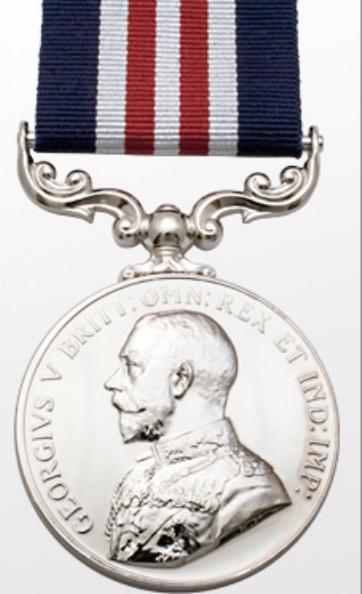
History
The medal was established during World War 1 on 25 March 1916. This is a military decoration awarded for land battles to members of the British Army and other services, and formerly also to personnel of other Commonwealth countries, below a commissioned rank. It is equivalent to a Military Cross (which is only issued to Officers and very occasionally to Warrant Officers).
Military Medal George V: World War 1 - 115,500 awarded
The George V has King George V's shows the Kings head on the front and royal cypher and Imperial crown on the reverse side with the inscription "FOR BRAVERY IN THE FIELD" in four lines, surrounded by a laurel wreath.
Military Medal George VI: World War 2 - 15,000 awarded
The George VI has King George VI's Kings Head on the front and the royal cypher and Imperial crown on the Reverse with the inscription "FOR BRAVERY IN THE FIELD" in four lines, surrounded by a laurel wreath.
In 1993 the Military Medal was discontinued and now the Military Cross is awarded to service personnel of all ranks.
Distinguished Conduct Medal
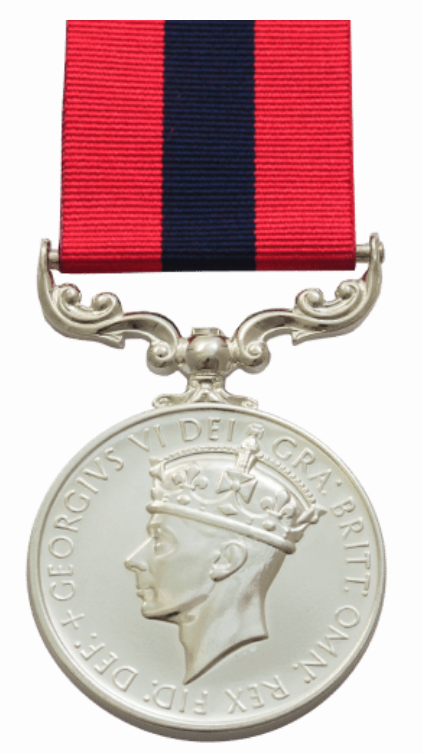
History
World War 1
The medal originally founded in 1854, during the Crimean War, to recognise gallantry within the other ranks of men who were not commissioned officers. It was a military decoration awarded to other ranks of the British Army and formerly also to non-commissioned service personnel of other Commonwealth countries.
The medal is made of silver medal. The original face of the medal displayed a trophy of arms as seen on early Army Long Service and Good Conduct Medals, but in 1902 this was replaced by the effigy of the reigning monarch. The reverse side bears the inscription "FOR DISTINGUISHED CONDUCT IN THE FIELD".
World War 2
From 1942 this award and medal was extended to members of the Navy and Air Force.
Bars were awarded in recognition of the performance of further acts of gallantry meriting the award.
All receipients are entitled to use the letters DCM after their name.
Victoria Cross
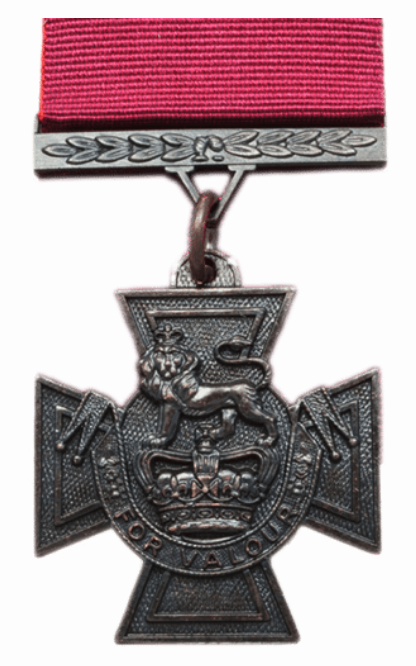
History
Queen Victoria issued a Warrant under the Royal sign-manual on 29 January 1856 to create the Victoria Cross. The Queen wanted a medal created for extreme acts of valour in the face of the enemy.
The traditional story is that the medals are all struck from the gunmetal from two Russian cannons captured during the siege of Sevastopol. This has, however, been disproved by recent research has shown that some medals may have been struck from Chinese cannons that may have been captured from the Russians in 1855. Each Victoria Cross bears the inscription FOR VALOUR. Originally it was to have said FOR THE BRAVE however, this was changed on the recommendation of Queen Victoria, as it implied that not all men in battle were brave. Every single Victoria Cross has been struck by Hancocks of London.
The Queen wanted an award for value which would not recognise birth or class. The War Office wanted to call it The Military Order of Victoria however the Queen vetoed this and named it the Victoria Cross. Although the Victoria Cross was instigated as a result of the Queen's warrant of 1856, it was back dated to 1854 in order to show recognition for conspicuous bravery, or some daring or pre-eminent act of valour or self-sacrifice, in the presence of the enemy in the Crimean War. The Queen, herself, issued / invested 62 of the 111 Crimean recipients in a ceremony in Hyde Park on 26 June 1857 in the first ever investiture ceremony. Typically the medals are bestowed by the reigning Monarch, immediate member of the Royal Family or some high ranking civil or military official.
In all cases, the investiture is recorded by the London Gazette, with the one notable exception when the Victoria Cross was given to the American Unknown Soldier of the First World War in 1921.
(The British Unknown Warrior was reciprocally awarded the US Medal of Honour)
Post World War 1
The orginal Royal Warrant did not contain a specific clause regarding posthumous awards. In 1920 the Royal Warrant was amended to specifically allow posthumous awards to be made. The original ribbon in the 1856 specification f stated that the ribbon should be red for army recipients and dark blue for naval recipients. The dark blue ribbons was abolished after the formation of the Royal Air Force on April 1st 1920. King George V changed this by signing a Royal Warrant on 22 May 1920 which stated that all recipients would receive the red ribbon and that all surviving recipients of the Naval ribbon were to exhange the ribbon for the new colour.
To this day the Victoria Cross may be awarded to any person, of any rank, in any service or to civilians under military command. In 1920 a Royal Warrant was also issued to specifically make provision for this award and medal to be extended to women serving in the Armed Forces - however, as yet, the offiical Victoria Cross it has never been awarded to a woman. (The closest to this was with the approval of Queen Victoria, Elizabeth Weber Harris was awarded a gold VC for her valour in nursing cholera-ridden soldiers in India in 1869)
Since then a total of 1,357 Victoria Crosses have been awarded to 1,354 men.
Interesting Facts:
In 1856, Queen Victoria laid the first Victoria Cross beneath the foundation stone of Netley Military hospital. The hospital was demolished in 1966 and "The Netley VC", was recovered and is now on display in the Army Medical Services Museum, Mytchett, near Aldershot. This is the only Victoria Cross which is never included in any official records.
Most number of VC issued in one day : 6 November 1857 18 issued during the 2nd Relief of Lucknow for the capture of Sikandar Bagh during the Indian Mutiny
The most number won in a single action: 14 - 22 November 1857 28 were issued for the whole of the Second Relief of Lucknow.
The most number won by a single unit during a single action: 22-23 January 1879. 7 were issued to the 2nd/24th Foot, for the defence of Rorke's Drift during the Zulu War. This was epitomised in the 1964 film Zulu. Link to the list of recipients
The most number won in a single conflict: World War 1 where 628 were issued. 1/4 of all of these were issued posthumously. Link to List of Recipients
Noel Chavasse and Arthur Martin-Leake, doctors in the Royal Army Medical Corps and Charles Upham, a New Zealander infantryman are the only three people to have been awarded the VC and Bar. The bar represents a second award of the VC.
181 Victoria Crosses were issued during World War 2 - Link to list of recipients
Distinguished Flying Cross
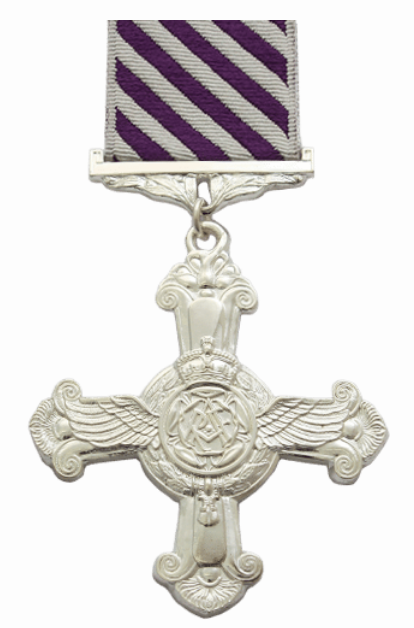
History
World War 1
The Distinguished Flying Cross was designed by Edward Carter Prestoni and is given to members of the Royal Air Force and other services, and formerly to officers of other Commonwealth countries, for "an act or acts of valour, courage or devotion to duty whilst flying in active operations against the enemy".
The award was established on 3 June 1918, It was originally awarded to air force commissioned officers and to Warrant Officers. The ribbon was originally white with purple broad horizontal stripes, but changed in 1919 to the current white with purple broad diagonal stripes. The horizontal and bottom bars are terminated with bumps, the upper bar has a rose. The front of the medal displays aeroplane propellers over the vertical arms of the cross and wings on the horizontal arms. In the centre is a laurel wreath around the RAF monogram and an Imperial Crown. The reverse side displays the Royal Cypher in the centre and the year of issue engraved on the lower arm and the recipient's name.
During the World War 1, a total of 1,100 Distinguished Flying Crosses were awarded, with 70 first bars and 3 second bars.
World War 2
During the Second World War this cross was also awarded to Royal Artillery officers from the British Army who served on attachment to the RAF as pilots-cum-artillery personnel. Since the Second World War, the award has also be given to army and naval flying officers, and from 1993 onwards it has been given to other ranks as well. the Distinguished Flying Medal, previously awarded to other ranks, has been discontinued.
Those who have recieved this gallantry award are allowed to use the letters DFC after their name. A bar is added to the ribbons for holders of this award who have recieved a second awards.
During the Second World War, 20,354 were issued. This is the most of any gallantry award. There were about 1,550 first bars and 45 second bars.
Honorary awards were made on 964 occasions to aircrew from other non-commonwealth countries.
Interesting Fact: In 2008, Flight Lieutenant Michelle Goodman became the first woman to receive the DFC gallantry award.
Airforce Cross
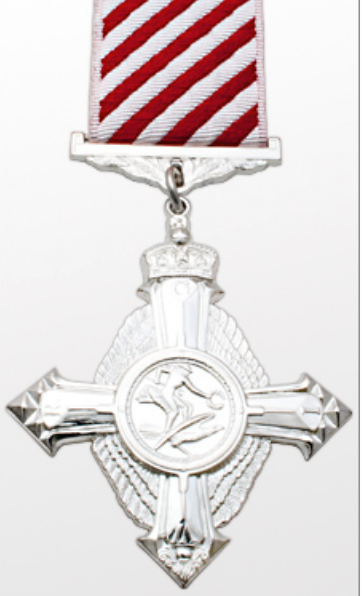
History
This award was initiated on 3 June 1918. It was, as seems quite often, originally only awarded to commissioned officers and warrant officers in the Air Force. Later on this was extended to include Army and Navy aviation officers after World War 2 and then in 1993 to other ranks after the Air Force Medal was discontinued.
First World War: 680 were awarded.
Second World War: 2,001 medals were awarded, with 26 bars awarded. A bar is added to the ribbon for holders who are awarded a second Air Force Cross. The ribbon was originally white with a broad red horisontal stripes, but in 1919 this was changed to broad red diagonal stripes at a 45 degree angle.
This cross is awarded to personnel of the UK Armed Forces, and formerly also to officers of the other Commonwealth countries, for "an act or acts of valour, courage or devotion to duty whilst flying, though not in active operations against the enemy".
Interesting Facts:
A unique second bar was awarded to Wing Commander H. J. Wilson in 1944.
To date 58 honorary awards have been made to aircrew from other non-Commonwealth countries.
Recipients of the Air Force Cross are entitled to use the letters AFC after their name.
George Medal
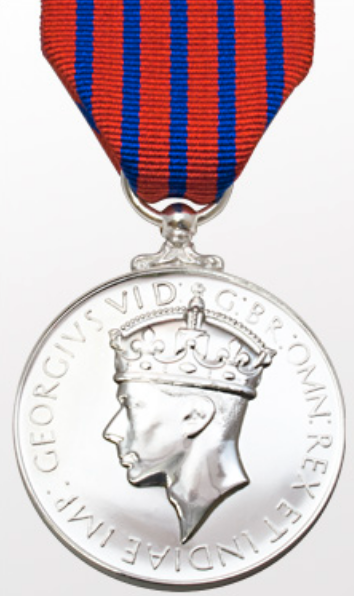
History
The George Medal is civil decoration of the United Kingdom and Commonwealth. The Royal Warrant was issued by King George VI on 24 January 1941 for the George Cross and the George Medal in order to show recognition of the many acts of courage exhibited by the civilian population during World War 2
The King - George VI said "In order that they should be worthily and promptly recognised, I have decided to create, at once, a new mark of honour for men and women in all walks of civilian life. I propose to give my name to this new distinction, which will consist of the George Cross, which will rank next to the Victoria Cross, and the George Medal for wider distribution"
Patrick King of Shiremoor in Northumberland was the first person to be awarded the George Medal. Patick, who was an air-raid warden rescued a blind woman from a house during an air-raid.
The original Warrant for the George Medal did not permit it to be awarded posthumously but this was amended in November 1977 to allow posthumous awards.
Recipients are entitled to the use the letters GM after their name.
Approximately 2,122 medals have been awarded since 1940.
British Empire Medal
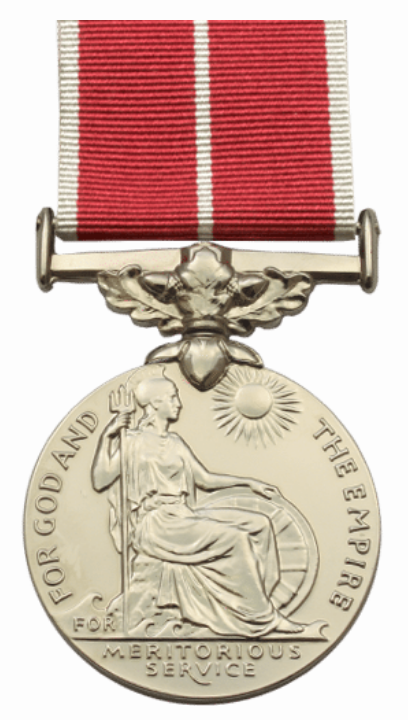
History
The Medal of the Order of the British Empire was first established in 1917 together with the Order of the British Empire itself. This medal was awarded 2014 times, 800 of which were for people from foreign countries. In 1922 the British Empire Medal was created to replace the Medal of the Order of the British Empire. It is a medal awarded for meritorious civil or military service worthy of recognition by the Crown. Like the original Order of the British Empire Medal is was split into two honours
The Medal of the Order of the British Empire for Gallantry (better known as the Empire Gallantry Medal) was awarded for acts of bravery until it was replaced by the George Cross in 1940,
The Medal of the Order of the British Empire for Meritorious Service (better known as the British Empire Medal) was awarded for acts of bravery but usually to people below management or professional level. In the uniformed services, it was awarded to non-commissioned officers of the armed forces, officers below superintendent rank in the police, and personnel below divisional officer level in the fire service.
After 14th January 1958 these awards were instead designated as the British Empire Medal for Gallantry and they comprised the Medal of the Order of the British Empire for Meritorious Service with a silver oak leaf emblem worn on the ribbon.
